Abstract
This paper shows that the empirical distribution of cross-sectional analyst coverage in China’s stock markets follows an exponential law in a given month from 2011 to 2020. The findings hold in both the emerging (Shanghai) and the developed market (Hong Kong). Moreover, the unique distribution parameter (i.e., mean) is directly related to the amount of market-wide information. Average analyst coverage exhibits a significant negative predictive power for stock-market uncertainty, highlighting the role of security analysts in diminishing the total uncertainty. The exponential law can be derived from the maximum entropy principle (MEP). When analysts, who are constrained by average ability in generating information (i.e., the first-order moment), strive to maximize the amount of market-wide information, this objective yields the exponential distribution. Contrary to the conventional wisdom that security analysts specialize in the generation of firm-specific information, empirical findings suggest that analysts primarily produce market-wide information for 25 countries. Nevertheless, it remains unclear why cross-sectional analyst coverage reflects market-wide information, this paper provides an entropy-based explanation.
1. Introduction
Sell-side analysts are among the most influential information producers in financial markets, playing a crucial role for both investors and managers. Numerous empirical studies have documented the impact of analyst attention (i.e., coverage) on investors’ decisions (e.g., [1,2,3]), as well as on corporate activities such as investment and financing, innovation (e.g., R&D), acquisition, and earnings management (e.g., [4,5,6,7]).
However, contrary to the conventional wisdom that security analysts specialize in collecting and disseminating firm-specific information, empirical findings indicate that analysts predominantly generate market-wide information for 25 countries [8,9]. It remains unclear why analyst reports reflect market-wide information rather than firm-specific information. To deeply understand the underlying mechanism, we examine the empirical distribution of cross-sectional analyst coverage.
This paper illustrates that the empirical distribution of analyst coverage for China’s listed companies maintains an exponential structure in a given month from 2011 to 2020. Our findings are consistent in both the Shanghai and Hong Kong stock markets. Since the system information of exponential distribution can be fully characterized by the mean value, we expect that aggregate analyst coverage can help reduce total uncertainty for both investors and managers. This paper provides evidence that aggregate (or average) analyst coverage, denoted by , exhibits a strong negative predictive power for stock-market uncertainty.
Given that cross-sectional analyst coverage is exponentially distributed, a natural question is how the exponential structure occurs. Motivated by [10], who draw on the maximum entropy principle (MEP) to interpret the asymmetric Laplace-shaped distribution of Tobin’ Q, we utilize the MEP to derive the exponential distribution of analyst coverage. The central idea is that when analysts, who are constrained by limited average ability in producing information (i.e., the first-order moment), aim to maximize the amount of market-wide information, this objective can yield an exponential distribution. To the best of our knowledge, it has not been documented in the previous literature that cross-sectional analyst coverage follows an exponential law. Our study is the first to provide an explanation for why analyst coverage predominantly incorporates market-wide information.
Our findings have some important implications. Firstly, sell-side analysts primarily generate market-wide information. Secondly, almost all relevant studies claim that coverage proxies should be used in logarithmic form to mitigate the influence of outliers; however, our results suggest that the exponential structure would be distorted when logarithmic transformation is performed. Thirdly, because more than half of the firms have similar coverage, future research should be especially cautious when using coverage proxies in cross-sectional and particularly in portfolio analyses.
2. Exponentially Distributed Cross-Sectional Analyst Coverage
Assuming a random variable X is exponentially distributed, it can be written as,
where , is the probability density function (PDF) with . Empirically, it is better to work with the complementary cumulative distribution function, i.e., CCDF: . The parameter can be obtained by the slope of the straight line on a semi-log scale: vs. x.
We examine the empirical distribution of cross-sectional analyst coverage in China’s stock markets. The sample consists of all common stocks listed on the Shanghai Stock Exchange (SSE), the Shenzhen S tock Exchange (SZSE), and the Hong Kong Stock Exchange (HK) from January 2011 to January 2020. The data are all from the Wind database. Table 1 presents the descriptive statistics of the monthly coverage data (i.e., x) for the three stock markets.

Table 1.
Descriptive statistics of monthly coverage data.
2.1. Evidence from the Shanghai, Shenzhen, and Hong Kong Stock Markets
The monthly results are shown in Figure 1. Two things are evident. First, the CCDFs show the highly skewed structure of cross-sectional analyst coverage. We observe that the percentage of firms with coverage below 10 is about 80%, i.e., a very high proportion of firms are covered by a small number of analysts, while certain firms have substantial coverage. Second, and most importantly, the empirical distributions are well fitted by Exp on both linear (CCDF vs. x) and semi-log (log CCDF vs. x) scales, where exponential fits are denoted as blue and red lines, respectively.
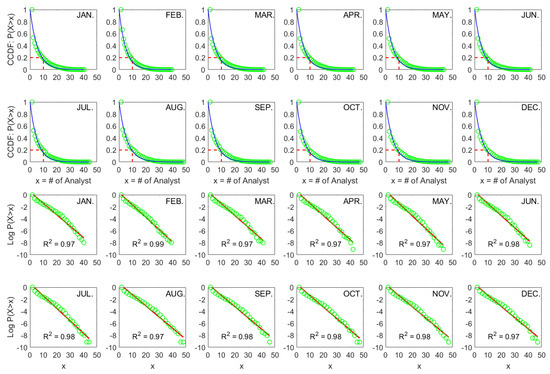
Figure 1.
Exponential fits of complementary cumulative distribution functions (CCDFs) of cross-sectional analyst coverage (x) on the linear (blue) and semi-log (red) scales for each month from 2011 to 2020 in the Shanghai stock market (SSE).
One might be intrigued by the goodness of fit; we thus present the regression in each semi-log subplot. On average, the is as high as 98% for the period 2011–2020. Notably, we do not exclude any coverage data based on any firm characteristics, which ensures that our findings provide a clean and complete picture of attention allocation structure of sell-side analysts.
Furthermore, as shown in Figure 2, a consistent exponential pattern of cross-sectional analyst coverage is evident for the Hong Kong stock market (HK), indicating that our findings are consistent in both emerging and developed stock markets.
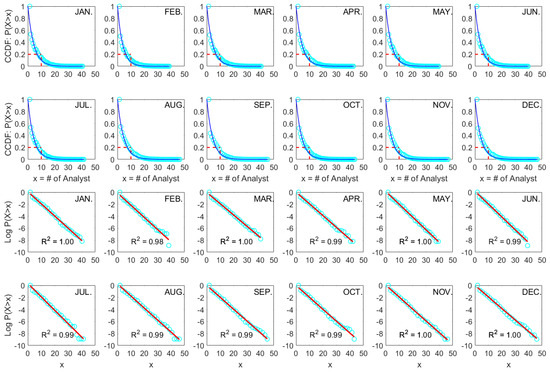
Figure 2.
Exponential fits of complementary cumulative distribution functions (CCDFs) of cross-sectional analyst coverage (x) on the linear (blue) and semi-log (red) scales for each month from 2011 to 2020 in the Hong Kong stock market (HK).
This paper argues that using coverage proxy to measure the amount of firm-specific information poses a serious inference problem. It is impossible that the amounts of information for firms with zero-coverage are exactly equal. After excluding firms with no coverage, of firms have almost the same small amount of analyst coverage. In any case, one cannot state that the majority of firms with approximate levels of coverage have similar firm-specific information environments.
By comparing the fitting results of the Shanghai (SSE) and the Hong Kong (HK) stock markets, it is observed that the HK data conform well to the exponential law, while the SSE data deviate from a linear relationship when expressed in log-linear form, especial as shown in Figure A1. It is an important question whether an exponential is the proper fit for the emerging markets such as the SSE. To address this concern, we further supplement the investigation with additional data from the Shenzhen stock market (SZSE). The monthly results for the SZSE are presented in Figure 3, showing a similar exponential pattern to that observed in the SSE. Figure 4 demonstrates that for large samples, exponential fitting performs better on both linear and log-linear scales in the SSE (a), SZSE (b), and HK (c) stock markets. The empirical distributions of coverage data deviate slightly from the exponential law in the long run. In other words, the deviation can, to some extent, be treated as a short-term phenomenon.
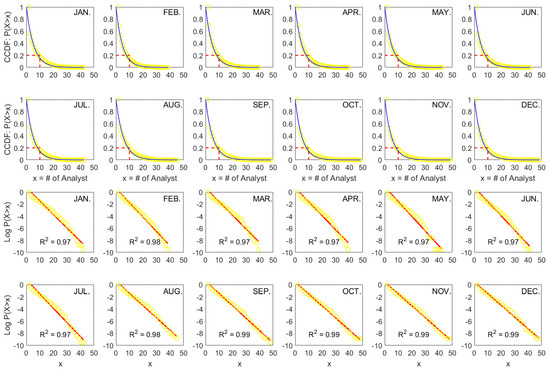
Figure 3.
Exponential fits of complementary cumulative distribution functions (CCDFs) of cross-sectional analyst coverage (x) on the linear (blue) and semi-log (red) scales for each month from 2011 to 2020 in the Shenzhen stock market (SZSE).
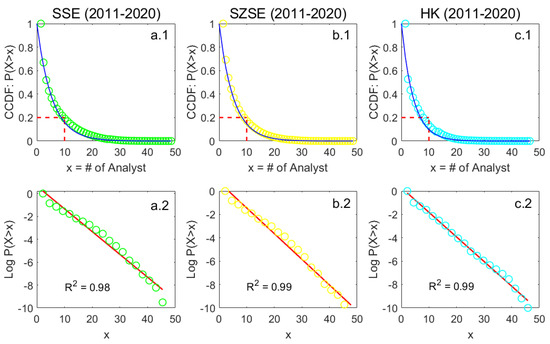
Figure 4.
Exponential fits of complementary cumulative distribution functions (CCDFs) of cross-sectional analyst coverage (x) on the linear (blue) and log-linear (red) scales during the period 2011–2020 in the SSE (a.1,a.2), SZSE (b.1,b.2), and HK (c.1,c.2) stock markets.
The goodness of fit is high for the period 2011–2020, reaching 0.98, 0.99, and 0.99, respectively. However, a closer inspection in the performance of exponential fitting reveals that the results for the SSE and SZSE stock markets do not follow a simple exponential law. There is a change in the gradient midway along the abscissa visible in all the graphs. Hence, we will conduct a detailed and in-depth evaluation of curve fitting in the next section.
2.2. Difference in Exponential Fitting between SSE, SZSE, and HK
In order to clearly observe the change in the gradient at the middle position of the abscissa, we divided the bins more densely when calculating CCDFs, increasing the number of bins from 20 to 50. Figure 5 assesses the exponential fits for cross-sectional analyst coverage (x) of the SSE (a), SZSE (b) and HK (c) stock markets in two scaling regimes, denoted as and . For the SSE and SZSE, even over the long term, the deviations in the fitted values of the two regimes are significant. Subplot c shows that the deviation is relatively small in the HK stock market.
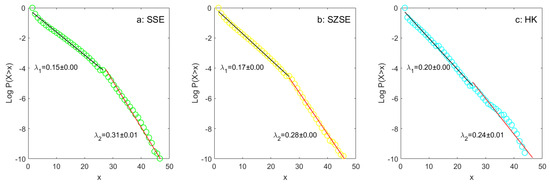
Figure 5.
Exponential fits of CCDFs in two scaling regimes (denoted as and ) for cross-sectional analyst coverage (x) of the SSE (a), SZSE (b), and HK (c) stock markets during the period 2011–2020.
Furthermore, we conduct statistical tests on this difference between SSE, SZSE, and HK. Panel A and B of Table 2 show the comparison results. The monthly fitted parameters, namely , , , and , are displayed in the first four columns. The last four columns illustrate the deviations between these scaling regimes. On average, we conclude that there are statistically significant breakpoints in the exponential fitting for the SSE and SZSE, while the cross-sectional analyst coverage for the HK market exhibits a simple scaling similar to an exponential law.

Table 2.
The difference in monthly fitted parameters between SSE, SZSE and HK.
The higher the costs of gathering information, the greater the potential resource constraints faced by security analysts. The relatively larger for firms with less coverage may imply that analysts need to spend more time and effort in studying and covering these companies, which are smaller in size and more prone to earning manipulation (e.g., [4,7]). Intuitively, this could be attributed to the lower market visibility of these companies or the relatively limited availability of relevant market-wide information about them. Deviation of exponential fitting across distinct scaling regimes is observed in the SSE and SZSE stock markets but not in the HK market, indicating a significant difference between SSE, SZSE, and HK. More importantly, can the difference in curve-fit bias serve as one of the distinguishing factors between emerging and developed stock markets? To effectively address this question, future research should provide richer comparative evidence across countries.
2.3. Predicting Stock-Market Uncertainty
2.3.1. Distribution Changes during the Period 2011–2020
Before demonstrating the negative predictive power of time-varying market information flows measured by on total uncertainty, it is necessary to illustrate how the statistical properties of the distribution evolved during the period. Figure 6 shows the fitted values of parameter (a) and sample mean (b) for cross-sectional analyst coverage of the Shanghai stock market (SSE) from 2011 to 2020. Additionally, as illustrated in Figure A1 in the Appendix A, it is observed that the empirical distribution maintains a stable exponential pattern for each year.
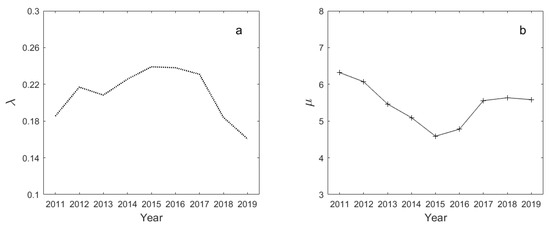
Figure 6.
Fitted values of parameter (a) and sample mean (b) for cross-sectional analyst coverage of the Shanghai stock market (SSE) for each year from 2011 to 2020.
An interesting fact is that the total amount of market information provided by sell-side analysts decreased significantly in 2015, as seen in Figure 6, and the maximum coverage number was the lowest during the sample period (see Figure A1). As we all know, the Chinese stock market experienced two crash crises in 2015 and early 2016.
Given the finding that sell-side analysts mainly generate market-wide information (see [8,9]), we go one step further and directly examine whether aggregate analyst coverage is related to stock-market uncertainty. In this paper, aggregate analyst coverage is denoted by the inverse of parameter , since fully characterizes the mean value of cross-sectional analyst coverage. The finding has many implications, and the most critical one is that aggregate analyst coverage exhibits a negative predictive power for stock-market uncertainty. If analysts have no advantage over insiders in generating firm-specific information, focusing on providing market-wide information becomes an inevitable choice. Next, we test the hypothesis that aggregate analyst coverage (denoted by ) can help reduce the expected total uncertainty.
2.3.2. Predictive Regression Results
We examine the forecasting power of aggregate analyst coverage denoted by for stock-market uncertainty based on the following time-series predictive regression,
where is the stock-market uncertainty over the prediction horizon h, where and 12 months, and j denotes two uncertainty proxies, which are market-level cash-flow volatility (i.e., CFV) and investor search volume (i.e., Search). is the inverse of the parameter of exponentially distributed analyst coverage in month t, which captures continuous-varying marker information flows. We also control for a linear time trend and lagged stock-market uncertainty up to five lags.
Our analysis in Table 3 is motivated by [12], who theoretically show that the expected amount of information generated equals the expected reduction in uncertainty. The idea is consistent with the foundational work in information theory [13]. Concretely, we construct two proxies for stock-market uncertainty that are closely related to managers and investors, respectively. One is market-level cash flow volatility, i.e., (e.g., [14,15]), which directly measures the uncertainty of operating management. The other is investor search volume denoted as . This is because theories of rational information acquisition predict that investors’ information-search demand increases in the uncertainty about asset payoffs (e.g., [16,17,18]).

Table 3.
Diminishing the expected stock-market uncertainty.
Table 3 suggests that an increase in aggregate analyst coverage is associated with an expected decrease in manager uncertainty (Panel A) and investor uncertainty (B), respectively. The results remain robust after controlling for a linear time trend and lagged stock-market uncertainty up to five lags in models (2), (4), and (6). In summary, we conclude that aggregate analyst coverage can alleviate total uncertainty for both investors and managers. Moreover, a higher aggregate analyst coverage also precedes lower market-wide cash holdings and the absolute magnitude of unexpected earnings, as well as greater capital expenditures and long-term debt. For more comprehensive and detailed evidence, see [20,21].
3. MEP Generates the Exponential Distribution
Finally, this paper attempts to provide a potential generation mechanism for the exponentially distributed analyst coverage. Motivated by [10], who draw on the maximum entropy principle (MEP) to interpret the asymmetric Laplace distribution of Tobin’ Q. In what follows we utilize the MEP to derive the exponential law. The idea of MEP is that in making inferences on the basis of partial information, we must use the probability distribution that achieves maximum entropy [22].
The concept of maximum-entropy optimization has been advocated in economic analysis (see [23,24]). In an economic context, examples of constraints that we impose include budget constraints, non-negativity of prices, average corporate profit rate (e.g., [10]), and behavioral constraints (e.g., limited attention in this paper).
Suppose that our only knowledge of analysts coverage distribution is the mean value (i.e., limited average-ability in producing information). Mathematically, the maximum entropy problem subject to the first-order moment constraint is as follows,
The Lagrangian associated with this programming problem is,
Taking the first-order condition and solving for yields,
The solution is an exponential distribution, which is fully described by the unique parameter . The first-order moment constraint condition is natural due to the fact that analysts have limited average capability in providing information. This entropy maximization property is perhaps the main reason why we encounter exponential distributions so frequently in mathematics and physics. One might ask what entropy, i.e., , means in our case. In the Shannon theory, this answer is clear. The average amount of information is given by the information entropy, i.e., , as Shannon pointed out [13]. Because analyst coverage can be viewed as a standard information source, maximizing the objective function is equivalent to maximizing the amount of market-wide information. Similarly, supposing we do not have any knowledge about distribution, the solution of maximum-entropy optimization is the Uniform distribution. In this case, when each firm has the same coverage (no firm-specific information), the amount of market-wide information attains the maximum value. In both cases, sell-side analysts generate market-wide information, not firm-specific information.
4. Conclusions and Discussion
Contrary to the conventional wisdom that sell-side analysts specialize in collecting and disseminating firm-specific information, it is found that analysts predominantly generate market-wide information for 25 countries (see [8,9]). However, it is still unclear why analyst coverage reflects market-wide information rather than firm-specific information. To understand the underling reasons, we examine the empirical distribution of cross-sectional analyst coverage.
This paper shows the following key findings: (i) the empirical frequency distribution of cross-sectional analyst coverage follows an exponential law, observed in both the Shanghai and Hong Kong stock markets; (ii) an increase in aggregate analyst coverage is associated with an expected decrease in total uncertainty; (iii) when analysts, who are constrained by limited average ability in producing information (i.e., the first-order moment), strive to maximize the amount of market-wide information, this objective yields the exponential distribution.
In summary, our findings offer two main insights. First, sell-side analysts in China’s stock markets predominantly contribute to market-wide information, illuminating their role in mitigating total uncertainty. Second, future research should be extra cautious when using coverage proxies in cross-sectional and portfolio analyses due to potential inference issues. Strictly speaking, it is advisable to carefully re-evaluate previous cross-sectional findings, if feasible.
Author Contributions
Conceptualization, Y.H. and C.H.; Data curation, Y.H.; Formal analysis, Y.H.; Methodology, Y.H.; Software, Y.H.; Visualization, Y.H.; Supervision, C.H.; Validation, C.H.; Writing—original draft, Y.H. and C.H.; Writing—review & editing, Y.H. and C.H. All authors have read and agreed to the published version of the manuscript.
Funding
This work was supported by the National Natural Science Foundation of China under Grant No. [71671134].
Institutional Review Board Statement
Not applicable.
Informed Consent Statement
Not applicable.
Data Availability Statement
All data are from the Wind database.
Acknowledgments
The authors are grateful to the editor and three anonymous referees for helpful comments. They are solely responsible for the specific views and any errors in the preceding article. Finally, one of the authors , Hou Y.F., would like to thank Li M.Y. and Hu C.Y. for discussions that were useful in the development of this work.
Conflicts of Interest
The authors declare no conflict of interest.
Appendix A. The Yearly Results for the Shanghai Stock Market (SSE)
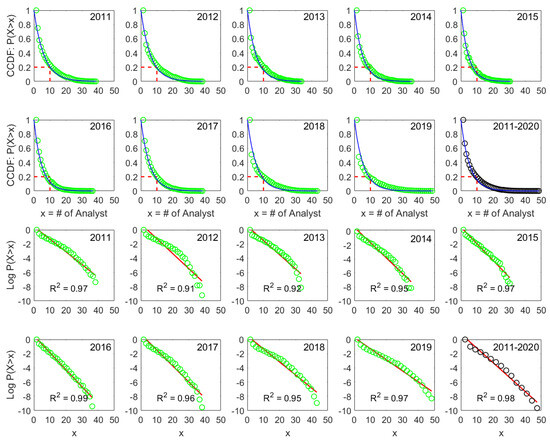
Figure A1.
Exponential fits of complementary cumulative distribution functions (CCDFs) of cross-sectional analyst coverage (x) on the linear (blue) and semi-log (red) scales for each year from 2011 to 2020 in the Shanghai stock market (SSE).
References
- Kelly, B.; Ljungqvist, A. Testing asymmetric-information asset pricing models. Rev. Financ. Stud. 2012, 25, 1366–1413. [Google Scholar] [CrossRef]
- Lee, C.; So, E. Uncovering expected returns: Information in analyst coverage proxies. Rev. Financ. Stud. 2017, 124, 331–348. [Google Scholar] [CrossRef]
- Guo, L.; Li, F.; Wei, K. Security analysts and capital market anomalies. J. Financ. Econ. 2020, 137, 204–230. [Google Scholar] [CrossRef]
- Yu, F. Analyst coverage and earnings management. J. Financ. Econ. 2008, 88, 245–271. [Google Scholar] [CrossRef]
- Derrien, F.; Kecskes, A. The real effects of financial shocks: Evidence from exogenous changes in analyst coverage. J. Financ. 2013, 68, 1407–1440. [Google Scholar] [CrossRef]
- He, J.; Tian, X. The dark side of analyst coverage: The case of innovation. J. Financ. Econ. 2013, 109, 856–878. [Google Scholar] [CrossRef]
- Chen, T.; Harford, J.; Lin, C. Do analysts matter for governance? Evidence from natural experiments. J. Financ. Econ. 2006, 115, 383–410. [Google Scholar] [CrossRef]
- Chan, K.; Hameed, A. Stock price synchronicity and analyst coverage in emerging markets. J. Financ. Econ. 2006, 80, 115–147. [Google Scholar] [CrossRef]
- Gao, K.; Lin, W.; Yang, L.; Chan, K. The impact of analyst coverage and stock price synchronicity: Evidence from brokerage mergers and closures. Financ. Res. Lett. 2020, 33, 101190. [Google Scholar] [CrossRef]
- Scharfenaker, E.; dos Santos, P. The distribution and regulation of Tobin’s q. Econ. Lett. 2015, 137, 191–194. [Google Scholar] [CrossRef]
- Newey, W.; West, K. A simple, positive semi-definite, heteroskedasticity and autocorrelation consistent covariance matrix. Econometrica 1987, 55, 703–708. [Google Scholar] [CrossRef]
- Frankel, A.; Kamenica, E. Quantifying information and uncertainty. Am. Econ. Rev. 2019, 109, 3650–3680. [Google Scholar] [CrossRef]
- Shannon, C. A mathematical theory of communication. Bell Syst. Tech. J. 1948, 27, 379–423. [Google Scholar] [CrossRef]
- Minton, B.; Schrand, C. The impact of cash flow volatility on discretionary investment and the costs of debt and equity financing. J. Financ. Econ. 1999, 54, 423–460. [Google Scholar] [CrossRef]
- Bloom, N. The impact of uncertainty shocks. Econometrica 2009, 77, 623–685. [Google Scholar]
- Da, Z.; Engelberg, J.; Gao, P. In search of attention. J. Financ. 2011, 66, 1461–1499. [Google Scholar] [CrossRef]
- Benamar, H.; Foucault, T.; Vega, C. Demand for information, uncertainty, and the response of US Treasury securities to news. Rev. Financ. Stud. 2021, 34, 3403–3455. [Google Scholar] [CrossRef]
- Neilson, J. Investor information gathering and the resolution of uncertainty. J. Account. Econ. 2022, 74, 101513. [Google Scholar] [CrossRef]
- White, H. A heteroskedasticity-consistent covariance matrix estimator and a direct test for heteroskedasticity. Econometrica 1980, 48, 817–838. [Google Scholar] [CrossRef]
- Loh, R.; Stulz, R. Is sell-side research more valuable in bad times? J. Financ. 2018, 73, 959–1013. [Google Scholar] [CrossRef]
- Hou, Y.; Hu, C. Understanding the role of aggregate analyst attention in resolving stock market uncertainty. Financ. Res. Lett. 2023, 57, 104183. [Google Scholar] [CrossRef]
- Jaynes, E. Information theory and statistical mechanics. Phys. Rev. 1957, 106, 620. [Google Scholar] [CrossRef]
- Foley, D. A statistical equilibrium theory of markets. J. Econ. Theory 1994, 62, 321–345. [Google Scholar] [CrossRef]
- Sims, C. Implications of rational inattention. J. Monet. Econ. 2003, 50, 665–690. [Google Scholar] [CrossRef]
Disclaimer/Publisher’s Note: The statements, opinions and data contained in all publications are solely those of the individual author(s) and contributor(s) and not of MDPI and/or the editor(s). MDPI and/or the editor(s) disclaim responsibility for any injury to people or property resulting from any ideas, methods, instructions or products referred to in the content. |
© 2024 by the authors. Licensee MDPI, Basel, Switzerland. This article is an open access article distributed under the terms and conditions of the Creative Commons Attribution (CC BY) license (https://creativecommons.org/licenses/by/4.0/).